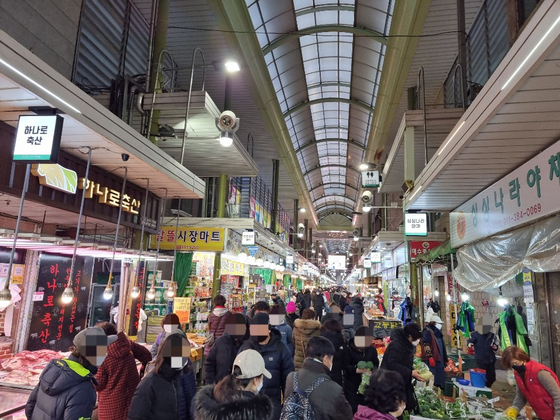
On the afternoon of the 3rd, Mangwon Market in Mapo-gu, Seoul. The market passage is full of customers who visit the market. Reporter Lee Byung-jun

A similar view of the World Cup market located across Mangwon Market Reporter Lee Byung-jun
Mangwon Market in Mapo-gu, Seoul at around 5:30 pm on the 3rd. The temperature fell below freezing and snow was scattered, but the market was crowded with customers who came out to buy things. Most of them seemed to be in their 60s or older, but there were not a few young customers who visited the market with croquettes or chicken in their hands. A delivery driver waiting for food to come out in front of the store for food delivery also stood out.
At the same time, the World Cup market just across Mangwon-ro was relatively busy. At the beginning of the market, you could see people pulling carts or carrying baskets, but there were fewer customers coming and going inside the market.
“Seoul Traditional Markets, Sales Declined 20~80% Last Year”
According to the Seoul Merchant Association, last year, sales of traditional markets in Seoul fell by 20% or 80% compared to the previous year. However, Mangwon Market, Hwagok Bondong Market, and Yeongdeungpo Fruit and Vegetable Market maintained a slight decrease in sales despite the novel coronavirus infection (Corona 19).
The merchant association explained that the presence or absence of’characteristic products’ split the traditional market in two last year. Pyun Jeong-soo, chairman of the Seoul Merchants Federation, said, “The market with typical food and specialty products maintained some sales despite the Corona 19 hit.” There are places where it is difficult to pay rent.”
Mangwon Market is famous for selling not only general fruits and vegetables, but also various foods such as tossed skate, chicken gangjeong, and croquettes. Gangseo-gu Hwagok Bondong Market is famous for selling jokbal and snacks, and Yeongdeungpo Fruit and Vegetable Market as a wholesale market, selling fruits at low prices.

Mangwon Market also sold various beverages such as Oreo Shake and Dalgona Coffee. Reporter Lee Byung-jun
Kim Jin-cheol, chairman of the Mangwon Market Merchants Association, said, “There are many restaurants, so there are customers who come from a distance with interest.” Seo Yoon-jung (53), who runs a seafood shop in Mangwon Market, added, “I have been a regular for 20 years, but nowadays there are a lot of young customers.”
On the other hand, in the World Cup market, the majority of stores selling food materials. Mr. Kim (49), who works at a vegetable store, said, “I can’t do business more and more,” and “I think the Mangwon market is going well.”
Mangwon Market is a relatively’young’ market compared to the World Cup market. Chairman Kim Jin-cheol explained, “Currently, Mangwon Market was just an alleyway to the old Seongsan Market (predecessor of the World Cup Market).” .
![A local market shopping service operated by Naver. [사진 네이버 캡쳐]](https://i0.wp.com/pds.joins.com/news/component/htmlphoto_mmdata/202102/07/ee6d038d-df67-435f-b9f0-2fa989534d47.jpg?w=560&ssl=1)
A local market shopping service operated by Naver. [사진 네이버 캡쳐]
Traditional market joining hands with online platform
Traditional markets also tend to use non-face-to-face service platforms such as Naver and delivery apps to survive the Corona era. ‘Neighborhood Market Shopping’, which Naver started pilot operation at Amsa Market in Gangdong-gu, Seoul in January 2019, expanded its service to 80 traditional markets nationwide last month. Coupang Itz also has been working with the Seoul city to support small businesses in traditional markets since July last year. There are over 50 traditional markets participating.
Merchants respond positively saying that collaboration with online platforms contributes to sales growth. Kim Song-i (27), a snack restaurant in the Mangwon market, said, “Last year sales were almost cut in half, but we started delivery and recovered to 80% of previous sales.” Chairman Kim Jin-cheol added, “Even in the traditional market, we can’t just sit there waiting for customers,” he added.
![On the afternoon of the 4th, the Sejong Traditional Market, Jochiwon-eup, Sejong City, is continuing to go to the market to purchase sashimi products. [연합뉴스]](https://i0.wp.com/pds.joins.com/news/component/htmlphoto_mmdata/202102/07/b18b09b6-a5c5-40fb-b2de-1e51fdbd3417.jpg?w=560&ssl=1)
On the afternoon of the 4th, the Sejong Traditional Market, Jochiwon-eup, Sejong City, is continuing to go to the market to purchase sashimi products. [연합뉴스]
However, as there are many elderly merchants who are not familiar with online platforms, most of the traditional markets are difficult to even try. Chairman Pyun said, “To introduce a delivery service, we need to change the way the store works, such as taking pictures of the menu and sending goods immediately when an order is placed.” I do” he emphasized.
Reporter Lee Byung-jun [email protected]
